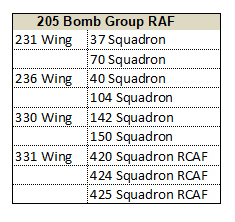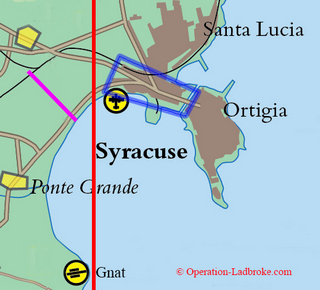Airborne assaults were vital to the invasion of Sicily, and the troops wanted shock and awe in the bombing of Syracuse. But the air forces kept them in doubt until the last minute.
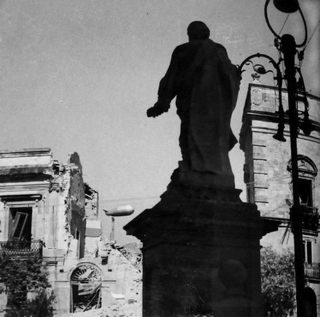
The plan for the bombing of Syracuse in support of the glider landings of Operation Ladbroke was delayed until the last minute, despite the overall plan being nearly six months old. The idea of starting the whole invasion of Sicily by first dropping airborne troops had been around since January. The specific plan to land gliders near Syracuse had been in hand since May. Yet as late as 9 July 1943, the day of Operation Ladbroke itself, Lt Col Goldsmith, the staff officer in charge of operations for the British 1st Airborne Division (1 AD), still did not know what air support his men might get.
Goldsmith had first visited 205 Bomb Group RAF on the 3rd of July, only a week from D-Day, the 10th of July. As the man responsible for 1 AD’s operations, he was very concerned at the lack of information so late in the day, especially given that specific target requests had been submitted by 1 AD to AFHQ (Allied Forces HQ, the supreme headquarters) on 23 May, nearly seven weeks before. 205 Group comprised several squadrons of Wellington medium bombers [photo], and it had been earmarked by AFHQ to provide bomber support for 1 AD. The squadrons were based at airfields around Kairouan in Tunisia, only some 40 miles west of 1 AD’s HQ near M’Saken (modern Masakin) [map].
It was an easy drive from M’Saken across the flat semi-desert [photo], which was just as well, as Goldsmith had to make the journey several times. His visit on 3 July, when he met Group Captain Simpson, SASO of 205 Group, was abortive. Simpson was “most cooperative and helpful”, but he had received no instructions from his bosses at Northwest African Strategic Air Force (NASAF). In fact, the “Group had heard nothing of their bombing role”. Unsurprisingly, “little progress … was made”.
On the 5th NASAF issued a directive listing diversionary targets, including Syracuse, so Goldsmith went back on the 7th. However Simpson had still not received specific instructions, but he promised to come with his Wing Commanders to a conference next day at 1 AD’s HQ in M’Saken.
The conference on the 8th was “most satisfactory”, but Simpson had once again still not received any instructions from higher authority. When Goldsmith, perhaps by now feeling a little desperate, went back on the day of the invasion itself, the 9th, there was news. Simpson had been promoted to Air Commodore and AOC. More to the point, he had also finally received specific instructions.
Goldsmith complained that even then there was a perception that the Syracuse mission was a diversion, designed to deceive and distract the Italians from the invasion, when in fact, for the glider operation, the mission had a very specific tactical purpose. He wrote:
“There was still no suggestion that this task had any connection with ground operations, nor was [this] information given [to 205] Group by N.A.S.A.F. at any later time.”
The Tail Wagging the Dog?
Goldsmith may not have known it, but Simpson had in fact gone to bat for 1 AD. Well after midnight on the 9th, at 1:32am, he sent a signal to NASAF telling his superiors what he intended, as opposed to waiting to be told:
“As a result of conference [with] Divisional Headquarters of [1 AD] there is no confusion [over] our immediate commitments, and any last minute alterations must be notified to us by [1 AD HQ]. The plan as arranged between [1 AD HQ] and ourselves is clear cut and any alteration will jeopardize complete Army plan.”
Simpson was effectively saying that the entire invasion of Sicily was in jeopardy if NASAF did not do what 1 AD asked. This flow of orders from 205 to NASAF was unusual, as orders of course usually flowed only one way, the other way, from NASAF to 205. Perhaps this cheeky signal was a reflection of not only the urgency, but also of the fact that it was Simpson’s first day in charge.
Simpson got a reply rated “EMERGENCY”, the highest priority, at 11:17am, 10 hours after his signal. It came not from some anonymous staff officer, but directly from NASAF’s head man, American Major General Doolittle. He was none other than the world-famous hero of the first bombing raid on Tokyo in 1942, an epic endeavour launched from an aircraft carrier far out in the Pacific.
Doolittle’s signal denied Simpson’s suggestion that 205 Group should launch a “maximum effort” (all available aircraft) on behalf of 1 AD. Instead he ordered the bombing of four additional towns, leaving fewer planes for the bombing of Syracuse. To be fair, this requirement had come at the last minute from lofty heights, from no less than the Army commander of the entire invasion, British General (later Field Marshal) Alexander.
Doolittle was restrained and only slightly snarky about Simpson’s cheeky message:
“These instructions do not agree with your existing arrangements with [1 AD]. Keep in mind fact that Wellingtons [are] required for other purposes than support and diversion for airborne troops. You should conform to above target instructions in addition to any arrangements made with [1 AD].”
If he saw this signal, Goldsmith might have flinched at the word “diversion”, even though it accompanied the word “support”. In fact, Doolittle was correct. 205 Group was providing both close support and diversions. The bombing of Syracuse was intended to directly support the advance of the glider troops. A second raid, timed to coincide with the glider landings, was planned against the distant city of Catania. It was designed to divert Italian attention from Syracuse. Whether the Syracuse raid was called “support” or a “diversion”, however, made no difference. The bombing plan for the city was the same.
Air Superiority
Goldsmith’s negative feelings about NASAF were symptomatic of Army distrust of the air forces across the board, especially the air forces’ refusal to commit. To many Army men (who had long believed that the airmen should be under Army control), it seemed like deliberate recalcitrance. It was not just 1 AD that had trouble getting the air forces to commit to giving support. It happened to commanders at the highest level, leading to complaints even from the admirals and the generals in charge of entire task forces.
In fact, the reason for the air forces’ lack of commitment made a lot of sense. Their top priority was to win air superiority over the Axis air forces defending Sicily, i.e. to so outnumber them that they could not operate effectively. This would be done by destroying their planes and smashing their bases, not by attacking ground targets that the Army wanted to be attacked. A single bomber could sink an Allied troopship carrying thousands of men. Enemy aircraft could attack troops, destroy bridges and smash docks, preventing the expansion and vital reinforcement of the initially tenuous bridgehead. It seemed better to banish enemy planes from the skies, rather than to pick at piecemeal targets on the ground.
The Army commanders, of course, wanted aircraft to support their ground operations directly. This would ideally take two forms. Firstly, by attacking targets in front of their troops. This was called ‘close air support’. Secondly, by preventing enemy reinforcements from reaching the battle. This was called ‘interdiction’. The air forces were adamant, however. There would be no close air support during the opening phase of the invasion, and they refused to commit to Army-specified interdiction missions while the outcome of the air superiority battle remained in doubt.
The air forces’ policy may have made sense, but it was very badly handled. Lists of targets that the Army wanted bombed were submitted to air forces HQ, but the requests were repeatedly rejected for no apparent reason. The Army felt the air forces were being evasive, vague and obstructive. One senior Army officer reported:
“The Air Plan, when it ultimately arrived, was described by an American General as ‘the most masterful piece of uninformative prevarication, totally unrelated to the Naval and Military [i.e. Army] Joint Plan, which could possibly have been published’. As regards targets for D Day bombing, these had not been even provisionally published by the time the Military Commanders finally embarked [for Sicily, on the 4th] (I have been given to understand that they were still being discussed); and the military forces were not informed at any time what bombing support, if any, could be expected.”
The Evolution of the Plans
In the end, it all worked out. The Allies did achieve significant (even if not total) air superiority by D-Day. It was enough to ensure that the Allies lost only a fraction of the number of ships they were expecting to lose. So the Army got some of its requests for interdiction air attacks. In particular, even though at the last minute, 1 AD got its requested bombing raid on Syracuse. Its purpose was to directly support the plans of the glider troops. The main aim of these plans was to facilitate the rapid capture of the port of Syracuse. The British needed the city’s magnificent harbour, so they could land supplies and reinforcements rapidly enough to stave off the inevitable enemy counter-attacks. The airborne plans were divided into three phases.
In Phase 1, upon landing by glider by night, the 2nd battalion of the South Staffordshire Regiment was to capture the Ponte Grande bridge near Syracuse, and then hold it open for seaborne forces coming up from landing beaches further south. The battalion also had to eliminate various Italian defences between the beaches and the bridge. Then, in Phase 2, the Staffords’ sister battalion, 1 Border, would cross the Ponte Grande and capture the western edge of Syracuse. In Phase 3, if things went well, the Border troops would advance before dawn to the isthmus where the island of old Syracuse (called Ortigia) was joined to the new town by a bridge (codenamed “Solent”). This would give the British control of the all-important docks, and would bottle up the Italian garrison of Ortigia, preventing counter-attacks.
205 Group was involved in supporting all these phases. The Group comprised nine squadrons of Wellington night bombers (37, 40, 70, 104, 142, 150, all British, and 420, 424, 425 Canadian) [photo]. These squadrons were grouped into four Wings (231, 236, 330, 331). Despite being formally organised this way, the Group acted as a whole, with the squadrons being subdivided so they could each participate in any of the operations. For example, small parts of seven squadrons attacked Catania.
The bombers supported Phase 1 by helping to ensure that all the gliders arrived undetected and unattacked. They did this in several ways. One way was by jamming enemy radar. Some Wellingtons were equipped with jamming equipment called Mandrel. These aircraft were to cruise all night 20 miles off the coast of Sicily to prevent the enemy radar stations from detecting the approach of the towing planes with their gliders. This task was considered a high enough priority for the air force supremo himself, Air Chief Marshall Tedder, to get involved. He visited 205 Group on the afternoon of the operation, and directly altered the timings for the Mandrel missions.
Another way the Wellingtons helped was by bombing distant Catania at the same time as the real glider landings were taking place near Syracuse, to “keep enemy RDF [radar] occupied during close approach of tugs and gliders”.
Small groups of Wellington bombers were also sent to bomb various small towns at roughly the same time. Their targets were Caltagirone, Caltanissetta, Canicatti and Palazzolo. Allied intelligence had identified the towns as places where Italian or German mobile forces were waiting to be deployed as rapid counter-attack forces in the case of invasion. These were the last-minute interdiction targets requested by General Alexander, but they also had a diversionary effect.
It was not just 205 Group that had aircraft supporting the glider troops that night. Hurricane fighters flew in the intruder role, seeking out Italian searchlights, to destroy them before they could pinion the gliders in their beams. Also, dummy paratroopers were dropped near Catania by Boston medium bombers of the Tactical Air Force. This, timed to coincide with the bombing of Catania by 205 Group, was designed to make the enemy think Catania was an airborne objective, to distract from Syracuse.
But the piece de resistance of 205 Group’s assistance for 1 AD, the mission employing most of its bombers, and the one that so concerned Goldsmith, was the raid planned in support of Phases 2 and 3, the capture of the town of Syracuse by the men of 1 Border.
The Boss
This raid was actively promoted by the commander of 1 AD, General Hopkinson. It was probably his own idea, but even if not, it certainly mattered to him enormously. Early in the genesis of the Operation Ladbroke plan, on 21 May, Hopkinson wrote to General Browning, the Allies’ airborne supremo at AFHQ. He described how he wanted what would today be called a “shock and awe” attack:
“I regard the intensive air bombing of LADBROKE [Syracuse] on night D – 1/D [9/10 July] as of first importance. There will arise here an opportunity of capturing the port by surprise at the outset – an opportunity which will never recur. The military force available is small. It can have little hope of a complete success unless the air bombardment is of such intensity that effective resistance by the enemy is very greatly reduced.”
Hopkinson was probably wedded to this plan for other reasons as well. There was his pride in his men, especially his glider troops, whom he had personally previously commanded. He was also dedicated to the cause of airborne forces. Not everybody believed that the potential achievements of airborne (and especially glider) forces were worth the cost of training, maintaining and deploying them. It would be a stupendous coup for the airborne cause if the glider force could capture the port of Syracuse single-handed.
A month later, on 20 June, Hopkinson issued 1 AD’s plan for Operation Husky, the entire invasion of Sicily, of which Operation Ladbroke was part. The copy of the plan in the archives includes a slip of paper that was apparently pinned to it as a late addition. It outlines the planned air support, including the bombing of Syracuse. In it, Hopkinson justifies the bombing in terms of saving the lives of his men:
“The bombing of LADBROKE is given the highest importance by Airborne Div Comdr [Hopkinson] as giving an opportunity of securing the port with the minimum cost.”
The plan of 1 Air Landing Brigade (1 ALB), which comprised the glider battalions, explained that the bombing would “neutralise any enemy holding the objective”. The word “neutralise” here is more than a euphemism for “destroy”. It also covers stunning, disrupting, demoralising and isolating the Italians so that they would be incapable of an effective defence.
This, rather than primarily the destruction of the enemy, was Hopkinson’s intention. He hoped the reduced resistance of the Italians following the bombing would allow his forces to occupy the new town right up to “Solent”, the bridge with the old town (Ortigia). He gave orders that Ortigia was not to be attacked. This may be because Ortigia was full of cultural treasures, such as churches and archaeological sites, which the Allies tried wherever possible to preserve. But the main reason seems to have been that it was easier and less expensive (not to mention more humane) to isolate and cut off the garrison, than it was to attack them:
“Every encouragement will be given to any inclination on the part of the garrison to surrender.”
Speed was of the essence. The glider troops had to advance immediately after the bombing, before the Italians had time to recover. It was known that the Italian Napoli Division had its depot barracks in Ortigia, and it was feared that as many as four of its battalions might be there. Four Italian battalions, even if two of them were only training battalions, could overwhelm the single glider battalion. If the British could disrupt any Italian troops in the new town, and then bottle up the rest in the old town on the other side of the Ortigia bridge, it would be better than trying to fight them. The plan of 1 Border, the glider battalion that had the job of taking Syracuse, explained:
“Concentrated bombing should cause such havoc as to enable us to establish a footing in the town before many of the enemy can cross the bridge to the mainland and put organised resistance in the houses.”
In order to achieve the rapid advance to Syracuse, the Border men would have to wait perilously close to the bombing, so that they were poised to move into the town as soon as the bombing stopped, while the Italians were still stunned. But it was known that night bombers sometimes missed their targets by miles. Professor Solly Zuckerman was a British scientist advising AFHQ on the bombing of Sicily. In a report in March 1943 he pointed out to the planners that average (not maximum) bombing errors, even in daylight, were “practically never less than 500 yards and are generally nearer 1000 yards”.
Despite this, the Border men were to wait along the Pisimotta Canal, just south-west of Syracuse (the pink line on Map 1). At its eastern end, the canal was only 600 yards from the Syracuse seaplane base (codenamed “Calshot”), which was to be bombed. Clearly there was a significant risk that British bombs could decimate the waiting British troops.
Target Area
The area to be hit was first described in Hopkinson’s 20 June airborne plan for Operation Husky. It specified a 400 x 1200 yard rectangle (in blue on Maps 1 and 2). This stretched from the Ortigia bridge at the eastern end of Syracuse new town, to the seaplane base and the main railway station (codenamed “Bulford”) at its western end.
By the time that last-minute orders were issued to the bomber squadrons, this large rectangle had evolved. It now consisted of two spot targets, the seaplane base and the main railway station with its marshalling yards. It still included an area target, but this was now much smaller. It was a very precise 370 yards wide corridor running diagonally across the eastern end of the new town, described by the RAF as “the isthmus”. It appeared as a cross-hatched shaded area on a map issued to the bomber crews (in beige on Map 2). The legend on the map read:
“BOMBS TO BE DROPPED ONLY IN SHADED AREA. THE AREA TO BE ATTACKED IS THE ISTHMUS … NO PART OF THE MAINLAND IS TO BE ATTACKED.”
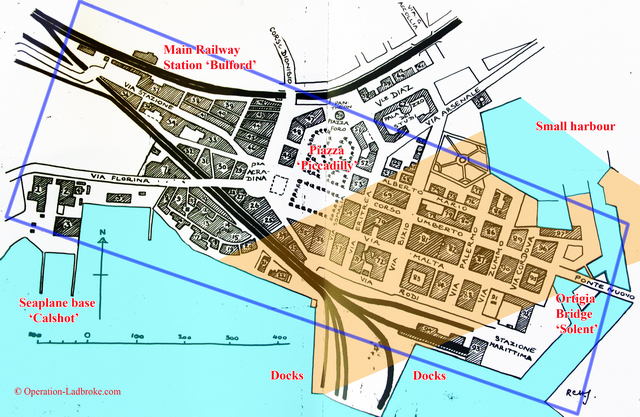
The map also showed the master “bomb line” (the red line on Map 1) that divided friendly forces from enemy areas. It was standard practice that no bombs should ever be dropped on the wrong side of a bomb line. On this occasion, however, the bomb line ran right next to a primary target, the seaplane base. This was risky, given the proximity of friendly troops.
The shaded 370 yards wide corridor on the map was angled so that sticks of bombs falling in a line along it would avoid the western part of Syracuse, the first part of the town that the Border soldiers would occupy in Phase 2. Bombing along the line of the corridor would also avoid bombs dropping on the northern residential suburb of Santa Lucia, which Hopkinson had also ordered should not be attacked.
Another advantage of the narrow corridor, compared to, say, a blanket bombing of both the whole of the new town and also Ortigia, was that it greatly reduced the target area. According to Professor Zuckerman, the ratio of bomb tonnage per square mile of target was the key factor in effectively disrupting the enemy. Shrinking the target area without reducing the number of bombers greatly increased this tons per square mile ratio.
Zuckerman suggested a minimum of 500 tons per square mile. He was thinking specifically of concrete defences which were hard to hit, but whose defenders could be demoralised and otherwise prevented from fighting. He added:
“It is conceivable that even so high a concentration would fail to deal decisively with some targets. For this reason […] as many bomber aircraft as can possibly be spared for an operation should always be used. One can very easily err by using too little; the maximum possible may not yet be enough.”
Zuckerman’s theories were tested in early June, when the island of Pantelleria, south-west of Sicily, was blasted in preparation for it being invaded by the Allies. Bombers dropped 1000 tons per square mile on the defences, double the suggested minimum. The result was dramatic – on the day of the invasion, the Italian garrison surrendered without firing a shot.
It is not known if Zuckerman influenced the weight of the bombing attack against the Syracuse isthmus a month later. He had been assigned to work directly with the top brass, including Tedder, who, as we have seen, took a personal interest in minute details of the night’s operations. So it seems possible.
If, however, Zuckerman’s work had nothing to do with the numbers, then they are strangely coincidental. The planners allocated 55 Wellingtons carrying standard GP (general purpose) bombs to hit the isthmus. This many bombers were capable of carrying 110 tons of bombs. The area of the isthmus corridor was about one tenth of a square mile. This gives a ratio of 1100 tons of bombs per square mile.
This was 10% higher than the double dosage that the Allies had dropped on Pantelleria, which had led to its surrender without a fight. It’s almost as if this many planes were allocated to the isthmus precisely because that number gave the Pantelleria ratio plus 10% contingency. Then four more bombers each carrying a giant bomb were thrown into the mix for good measure. The remaining bombers were divided up among the other five targets, with each getting only a small fraction of the number set aside for Syracuse, as if no more could be spared from the shock-and-awe operation.
Spot Targets
The two spot targets in Syracuse were also not part of the shock-and-awe onslaught on the isthmus.
One was the seaplane base. In peacetime this was Syracuse’s airport, frequented by huge flying boats carrying wealthy passengers in the first heyday of air travel. Now it was a multiple threat to the Allies. The greatest was the Italian seaplanes anchored in the harbour, which could be used both in the reconnaissance role and in the attack role, as torpedo bombers. Also, their air force crews were capable of armed resistance on the ground, and the base was surrounded by light anti-aircraft guns.
The other spot target was the marshalling yards and the main railway station codenamed “Bulford”. Disabling the tracks and switching gear here would prevent their use by Axis reinforcements, or by the armoured and armed trains known to be in the area. The Allies wanted the railways for themselves, so it may seem counterintuitive to bomb them. But they also knew that railways were comparatively easy to fix, with everything needed for repair usually close at hand. It would however take time, time the Italians would not have.
Confusingly, there were two other railway stations in Syracuse. One of them, the Maritime Station, was by the quayside of the docks (“Stazione Marittima” on Map 2). The docks were also full of railway sidings that could be mistaken for marshalling yards. In an apparent oversight, the Maritime Station was marked “RAILWAY STATION” on the target map given to the bomber crews. The correct target, the main station, Bulford, was not marked at all. This was corrected by hand using coloured chinagraph pencils on the copy of the map at 205 Group. It is not known if this correction was made on the maps that were sent out to the wings. We know that in at least one case it was not.
205 Group orders specified that the two spot targets were to be attacked with 500 pound bombs [photo], fused for a time delay of a fraction of a second. The tiny delay allowed the bombs to penetrate slightly before exploding, making the resulting explosion much more destructive of buildings and infrastructure.
By comparison, the orders specified that the isthmus corridor should be hit with of 250 pound bombs, fused to explode instantly. Falling among buildings, these smaller bombs (up to 1000 of them) would saturate the area and fill the air with flying rubble. Four “blockbuster” bombs were also to be dropped on the isthmus. Each weighed 4000 pounds and generated an enormous blast. Apart from the damage they caused, these monster bombs [photo] were very much “shock and awe” weapons.
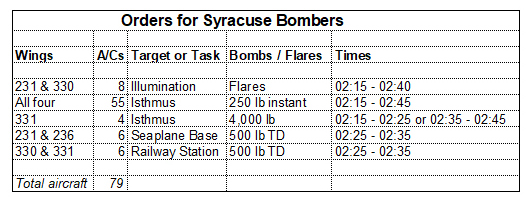
One potential spot target also appeared on the target maps, but precisely so that the bomber crews knew that they must NOT attack it. This was an AA gun battery codenamed “Gnat”, which was almost on the bomb line. It was due to be captured by the glider pilots, so obviously any attack by the Wellingtons risked killing their own men. The glider pilots would have been amused to read in the 205 Group orders that Gnat was to be avoided because it was “the perquisite of ‘the cloak and dagger men'”. The phrase smacks of SOE agents, or SAS saboteurs, or commando raiders, whereas in fact the glider pilots, when assembled for combat, constituted a battalion of highly trained infantry.
Taking No Chances
To avoid hitting Gnat, the bombers needed to be able to see it. And one spot target, the seaplane base, was so close to the waiting troops that it needed precision bombing. The area target, the narrow 370 yards wide corridor in the isthmus, also demanded unusually great accuracy in bombing.
For this reason the 205 Group orders specified that no less than eight Wellingtons (10% of the Syracuse force) should be assigned to be “illuminators”. This meant that they would continually drop flares above Syracuse until 5 minutes before the end of the raid. The 5 minute gap allowed total darkness to return before the Border men rose from their positions along the canal and advanced on the city.
A Wellington without bombs was capable of carrying 50 flares, giving a possible total of 400 flares for the mission. Each flare burned with a 750,000 candlepower brilliance. Across the 35 minutes of their use during the raid, 400 flares represented a notional average of one flare every five seconds, an astonishing number. Scores of them would be alight at the same time, as each one lasted for up to 4 minutes. The orders commented:
“The success of this most important mission depends in a large measure on accurate illumination.”
The whole invasion of Sicily was deemed to depend on the rapid capture of a port, Syracuse. The capture of Syracuse depended on the glider troops. The glider troops were depending on the bombers. And the bombers were depending on the flare droppers. The planners were taking no chances with the number of flares.
.
This article is Part 1 of a two-part series. Part 2, “The Raid”, will appear in due course.
The story of a submerged Wellington wreck from this raid appears [here].
Information about the Vickers Wellington medium bomber:
1943 map of Syracuse underlying Map 2 courtesy of Border Regimental Museum

